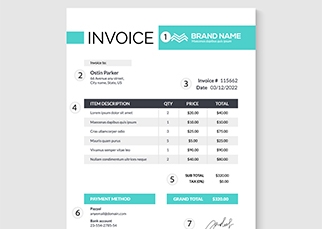
What you’ll learn:
- Why write a business plan?
- What should a business plan include?
- How to create a business plan
- Tips for writing a successful business plan
Creating a business plan is an important task when you want to start a new business or want to expand your current one. Getting your ideas down on paper (or more likely in digital documents) is a practical way to map your business purpose, identify market opportunities and assess your chances of success.
Preparing to launch your new business from home? Weighing up whether it will work? Start by writing a business plan. It can reassure any concerns and show if your goals are realistic. Even if you’re keen to get going, putting a plan in place first should keep your company on the right track.
Why write a business plan?
A business plan is the blueprint you build your business on. It outlines your company’s purpose and aims. Information around your structure, strategy, operations and finances come together in one place. This gives you a good early idea of whether your business idea can realistically work.
A business plan isn’t only useful for you. Potential financers might ask to see your business plan early on before deciding to invest. Business plans are flexible and over time may adapt to new goals, circumstances and directional changes.
A few reasons for creating a business plan are to:
- Provide clarity. Setting out your strategy clearly can focus your ideas and help you set concrete objectives. Refine your goals and actions.
- Secure funding. Most investors and financers will ask to see your business plan. This may be their main resource to decide whether they’ll provide funding, so it needs to be strong.
- Test your feasibility. Writing a business plan is a simple way to see if your idea can realistically work. With your concept, strategy and finances in one place it can highlight any major problems before you get started.
- Identify opportunities. Spot gaps in the market and in your plan that need addressing to fix potential issues in advance.
- Attract investment. Especially if your business starts to grow, you may need more funding. A solid, developing business plan reassures investors.
What should a business plan include?

The style and structure of business plans can vary. It usually depends on the company, industry and its goals. Most follow a similar layout and include a few basics, whether for internal or external use.
When creating a successful business plan, as a minimum you should include:
Executive summary
This is a top-level overview of your business plan. It basically sums up each area of the plan in no more than two pages, highlighting your:
- Mission
- USP(s)
- Product and service offerings
- Management and ownership
- Target market
- Financial projections
- Funding requirements
The market
You should include a general overview of any market trends, sales data and demographics, alongside the conclusions drawn from your market research.
A simple way to break down the market and your business is by thinking about:
- A specific problem in your market that your business addresses.
- What your solution is and how it meets customer needs.
- Who your competitors are and their strengths and weaknesses.
SWOT analysis
A SWOT analysis is comprised of four sections within your business plan that you need to identify. These are its:
- Strengths
- Weaknesses
- Opportunities
- Threats
Later on, we will take a more detailed look at what this step involves.
Strategy
A key part of the plan, this outlines how you will operate on a daily, weekly, monthly and yearly basis. It should include your methods of promotion, pricing structure, getting products and services to market and ways of measuring your strategy’s effectiveness.
Financial information
Whether you’re a new or existing business, the financial information should detail how you plan to operate and become profitable. Current businesses can use your existing statements. New ones should use projections for the:
If your business is looking for investment, include a funding request here.
How to create a business plan

Once you have a template for your business plan in place, it’s time to fill it in. Each section needs to be detailed and include accurate information. This gives you and any potential investors a realistic outlook for your business.
Get started with these tips for creating a successful business plan.
Write a strong executive summary
The executive summary is relatively short but holds great importance as the first part of your business plan that anyone reads – so it needs to be brilliant.
Essentially a condensed version of your plan, it can be easier to write last. Always get someone else to proof it afterwards, but for a strong executive summary make sure you:
- Get the right length. Keep it between five and 10% of the total business plan, no more than two pages.
- Use appropriate language. Active language and short paragraphs and sentences make it engaging. Remember who the audience is and use acronyms and avoid business-speak where possible. Keep it simple and explanatory, as investors may not be familiar with industry jargon.
- Format effectively. Short sentences and paragraphs improve readability, helping the executive summary flow naturally. Include an introduction, quote, stats and data, table of contents and conclusion to reiterate the key message of your business plan.
- Highlight key points. Introduce top-level information to capture the reader’s attention. Think statements, supporting data and your key selling points.
- Separate it from the plan. The executive summary needs to stand alone from the rest of your business plan. Read it on its own to ensure it makes sense and covers all the key points.
Understand your market
Your business plan requires detailed, up-to-date customer and market research that demonstrates good sector knowledge. Precise sales data, market trends and other relevant figures can support your business idea.
Use it to show a clear, profitable opportunity to investors, that reaffirms your plan as realistic. Present this using stats, graphs and tables for ease of comprehension.
To help set your business apart and test its feasibility, there are three key things you should consider:
- Problem. Where is the current market opportunity that your business will fill? It could be a customer pain point, service issue, or introducing something new to the sector. Outline any supporting data that shows the problem exists and needs resolving, defining the target audience.
- Solution. Explain the target market for your business and how your offering provides a solution. Estimate the size and value of sales required to deliver this, alongside any economic or demographic shifts that could affect it.
- Competition. Cover off other businesses in the sector, what they do well and any sales data that aligns with your aims. Make it clear how your business will stand apart. Present your estimated volume and value of product/service sales and how they will outperform your competitors.
Include any market challenges that could present barriers here, too. This could be related to finances, technology developments, regulation, market location, or anything else relevant.
Conduct a SWOT analysis

A SWOT analysis is vital to assess whether your capabilities match the realities of starting the business. It can help identify challenges and plan how you will overcome them in advance, saving time and money otherwise spent dealing with them in the future. It can also highlight opportunities, so your company focuses on areas where it will thrive.
To create a SWOT analysis for your business plan, draw up a list of its strengths. Split these into two camps – those that help take advantage of market opportunities, and those that ward off potential threats. Do the same for weaknesses, but with those that need improving, to take advantage of opportunities and those that may create a threat.
Put these into a grid and mention in your plan how you will eliminate or improve weaknesses, capitalise, and monitor strengths. This could change your business’s direction.
Assess the competition
One of the main questions any potential investor will have is ‘how does your business differentiate itself from the competition?’
Thorough competitor research can support your idea. It should show the business’ chances of success and outline your strategy to achieve your goals. A good way to present this can be in a table that compares key data points for each competitor, like this.
| Your business | Competitor 1 | Competitor 2 | Competitor 3 | |
| Estimated annual revenue | ||||
| Product/service pricing | ||||
| Number of employees | ||||
| Quality of products/service | ||||
| Target audience demographics | ||||
| Reputation |
Make it clear how your business will improve on the competition’s strengths and stand apart, in terms of these factors and other relevant measurables. Be realistic. Alongside any advantages you hold over the competition include weaknesses and how you aim to eliminate these.
Depending on the industry and location it can be worth mentioning competitor sentiment and their possible response to our new business. Explain how you will respond and position yourself to avoid treading on toes.
Form an effective marketing and sales strategy
This is the core of how your business will operate. It reassures both you and the reader that everything has been thought through, researched and is feasible.
A detailed section, ensure it touches on everything related to producing, marketing and selling your products or services. Key areas to cover include:
- Market positioning. Where and how your business places itself in the market. What benefit/USP does it focus on? Is it high-end or affordable?
- Pricing. Your pricing policy, explain the reasoning behind it based on customer expectations, profit margins and value.
- Promotion. How you will advertise, market and promote your business. Where will you advertise and what will be your promotion spend?
- Sales. Cover the sales channels you plan to use, the expected sales time and value, distribution channels.
- Business operations. Details around your business premises, production facilities, supply chains, IT systems, management and personnel structures.
Plan your financial future

The financial plan element demonstrates to investors and yourself how your business intends to be profitable and grow in the future. Existing companies can include your current financial information here. New ones need to add forecasts for four key areas:
- Balance sheet. This summarises your business assets, equity and liability at a particular time (opening day for new businesses). It shows what you own, owe and the net difference.
- Breakeven analysis. This includes details around how many sales you need to make to break even and profit.
- Income statements. Your projected revenue, expenses and profit, which can be broken down monthly. This should tally with the rest of your plan, based on pricing structure, liabilities, assets and equity.
- Cash flow statements/projections. Demonstrating how much money you estimate to have coming in over a set period and what you’ll also pay out.
This should all be accurate and based on hard data, demonstrating to potential investors that you have a profitable business model.
Tips for writing a successful business plan

Creating a successful business plan to guide your new start-up is vital. Use it as guidance to stay on the right track, encourage investment and improve your chances of success. It doesn’t have to be overly long and complex either.
A few key tips to make it effective:





Are you an aspiring business owner? Inspiring entrepreneurs share their secrets for success. Get valuable advice from inspiring entrepreneurs and make your move.
Learn about Ade Hassan's journey

Wondering how to start a business from home? Read our guide for work from home tips and business ideas. Kick start your small business with Adobe Acrobat.

A document management system could be the key to making your business run smoothly. Find out how to set one up with Adobe by using our guide.

Invoices ensure you get paid for your products or services. Discover how to create an invoice and start digitalising your payments with Adobe Acrobat.
Get Adobe Acrobat Pro
The complete PDF productivity solution. Edit, convert, share and sign documents anywhere, anytime. 7 days free, then .